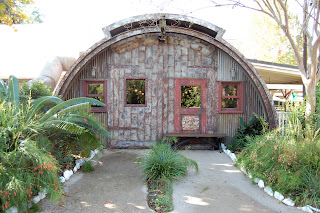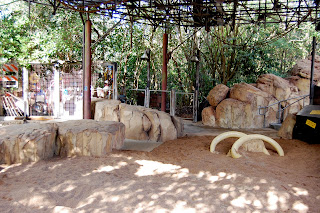When the Dino Institute outgrew their facilities in the old fishing lodge, they moved into the modern edifice we see today. The current museum building was constructed well away from the unruly environment of the dormitories and even further removed from other undesirable neighbors (Chester & Hester anyone?).
The Dino Institute stands in stark contrast to the rest of Diggs County's environs. Separated by commanding monuments and set amidst beautifully manicured grounds, the Institute is a model of professional excellence and decorum. Visitors hoping to gain a true education in the area's paleontological history are invited to visit the museum and its current marquee exhibit, entitled "DINOSAUR." (The attraction, originally called "Countdown to Extinction," draws elements from the 2000 Disney film Dinosaur. In addition to the name, the statue out front was also changed from a Triceratops to Aladar, the Iguanodon hero of the film.)
Pause for a moment before entering the museum, and you'll notice this dedication plaque, stating the opening date of the facility as April 22, 1978 (exactly twenty years prior to the opening of Disney's Animal Kingdom). The concrete structure is in line architecturally with buildings from the late '70s period.
Once inside, take time to peruse what new Institute Director Dr. Helen Marsh describes as "those quaint exhibits in the old wing." They're actually very interesting, showing us examples of living things still around from the days of dinosaurs as well as a variety of theories for why dinosaurs became extinct.
Just as the professors and interns disagreed on how to interpret some of their finds, the Dino Institute Museum's displays present several theories on extinction. Were the dinosaurs killed off by a massive asteroid impact, or was it something else like the spread of disease or the rise of mammals? Perhaps it was a combination of these things.
Once we get into the main room of the museum, though, it becomes clear that the Dino Institute feels the asteroid impact was the primary cause. We are presented with a wall-size recreation of the earth's strata, showing the ashy gray layer known as the KT Boundary. Scientists believe this layer was formed as the ash and soot from the asteroid impact settled back down to earth. Most significantly, dinosaur fossils are only found below the KT Boundary, implying that the creatures did not survive the event.
The center of the room is dominated by the massive skeleton of a Carnotaurus, the horned predator featured as antagonist in the Dinosaur film and in the attraction of the same name (more on that tomorrow). For dramatic purposes, the size of Carnotaurus has been exaggerated (it would have been slightly smaller, about 25 feet long) and its red color has been imagined to give it a more menacing appearance.






















































